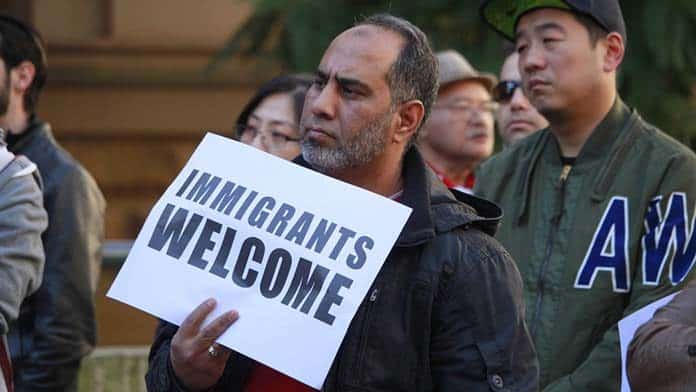Peter Mares’ book, published mid-last year, argues there has been a significant shift towards temporary visas away from permanent migration in Australia. He sets out to uncover the impact on temporary migrants, who can go years living in uncertainty without the rights held by other workers.
Migrant workers on 457 temporary work visas have been scapegoated for unemployment by Malcolm Turnbull, the unions and Labor leader Bill Shorten alike. Turnbull has now replaced 457s with two similar temporary work visas.
But those on temporary visas also include international students, working holiday makers, New Zealanders and even refugees. They are denied a whole host of rights that come with permanent status.
Mares illustrates the pitfalls of temporary migration through the personal stories of, among others, a new wave of Italian migrants resulting from Europe’s economic crisis and Greek migrants recruited to work with the Greek population in an old people’s home.
Mares looks at how temporary migrants have less rights when something—whether losing their job, an injury at work or relationship breakdown—goes wrong. Swan Services Cleaning, which went broke in 2013, owed millions in unpaid wages and annual leave entitlements to its 2500 workers. A federal government scheme established to deal with corporate collapses guaranteed the money owed to Australian citizens and permanent residents. But many of the company’s workers were international students, who got nothing. The same is true of workers’ compensation benefits if someone injured at work on a temporary visa has to leave the country.
This lack of rights also leaves them vulnerable to exploitation—particularly in the case of temporary work visa holders. If they lose their job, they must find a new employer within 60 days, or face deportation.
Most want to become permanent residents. This requires employer sponsorship after three years of working for the same company, putting workers at the mercy of their boss. Turnbull’s changes mean some migrants on temporary work visas lose any chance to transition to permanent residency. Some might be able to switch to a different visa, such as a partner or student visa. Most won’t stay.
Abuses
Because of their vulnerable position, temporary visa workers have sometimes been exploited, with companies paying them less than either the market rate or the minimum $53,900 wage required by law.
Mares has tried to quantify this using Fair Work Ombudsman investigations. Breaches of the law have been found at one quarter of the workplaces employing 457 visa workers investigated. This is likely to overstate the problems, he argues, as the Ombudsman targets companies where there have been complaints or suspicion of abuses.
Workers on 457 visas have been labelled as a threat to “Aussie jobs”. Mares rightly rejects the idea there is any, “simple equation between adding a foreign worker and taking an Australian job”. He points out every extra migrant needs housing, food and other services, creating more demand and more jobs. A migrant who fills a skills shortage can mean a company employs other workers, for instance, “a foreign cook… may create jobs for Australian wait staff or butchers or vegetable growers or delivery drivers”.
New Zealand citizens in Australia are also classed as temporary migrants, Mares explains, even though they have an automatic right to live and work here. Since 2001 they have been denied welfare payments including unemployment benefits and must pay up-front fees for university courses.
Unless they can move onto another visa, most likely a skilled migrant visa, New Zealanders have no pathway to permanent migration and citizenship rights. As many as 200,000 New Zealanders work in low skilled jobs and have no prospect of this. One result is that New Zealanders, particularly Maori, end up living on the streets, including kids who migrated with their families.
Here to stay?
The number of workers on 457 visas alone is small—there were just 81,300 in Australia at the end of 2016, around 0.7 per cent of the workforce.
But overall temporary migration has grown by three quarters in the last ten years, so that there are now over one million people living in Australia on all kinds of temporary visas. Mares estimates they make up 8 to 9 per cent of the workforce.
Many of those who arrive on temporary visas are not simply here temporarily. Australia’s immigration program is now largely a “two-step program”, Mares argues, where migrants arrive on a temporary visa before gaining permanent migration status.
He shows that 457 visa workers are among the most likely to end up settling here permanently—over 40 per cent who arrived in the last decade did so.
Turnbull’s recent changes mean most people on the new Temporary Skills Shortage visas will not be able to move onto permanent visas.
There are estimates that 15,000 people a year will lose this right, reducing the percentage of the permanent skilled migrant quota who have arrived on temporary visas from roughly 60 to 50 per cent a year. But temporary migration will remain an important path towards permanent residency.
If unions continue to blame temporary migrants for unemployment, they will cut themselves off from a large and growing part of the workforce. Campaigning to keep out temporary migrants is the wrong approach. We need to fight for them to have the same rights as permanent migrants so they are less vulnerable to exploitation and abuse.
By James Supple
Not quite Australian: How temporary migration is changing the nation
By Peter Mares
Text Publishing, $32.99






